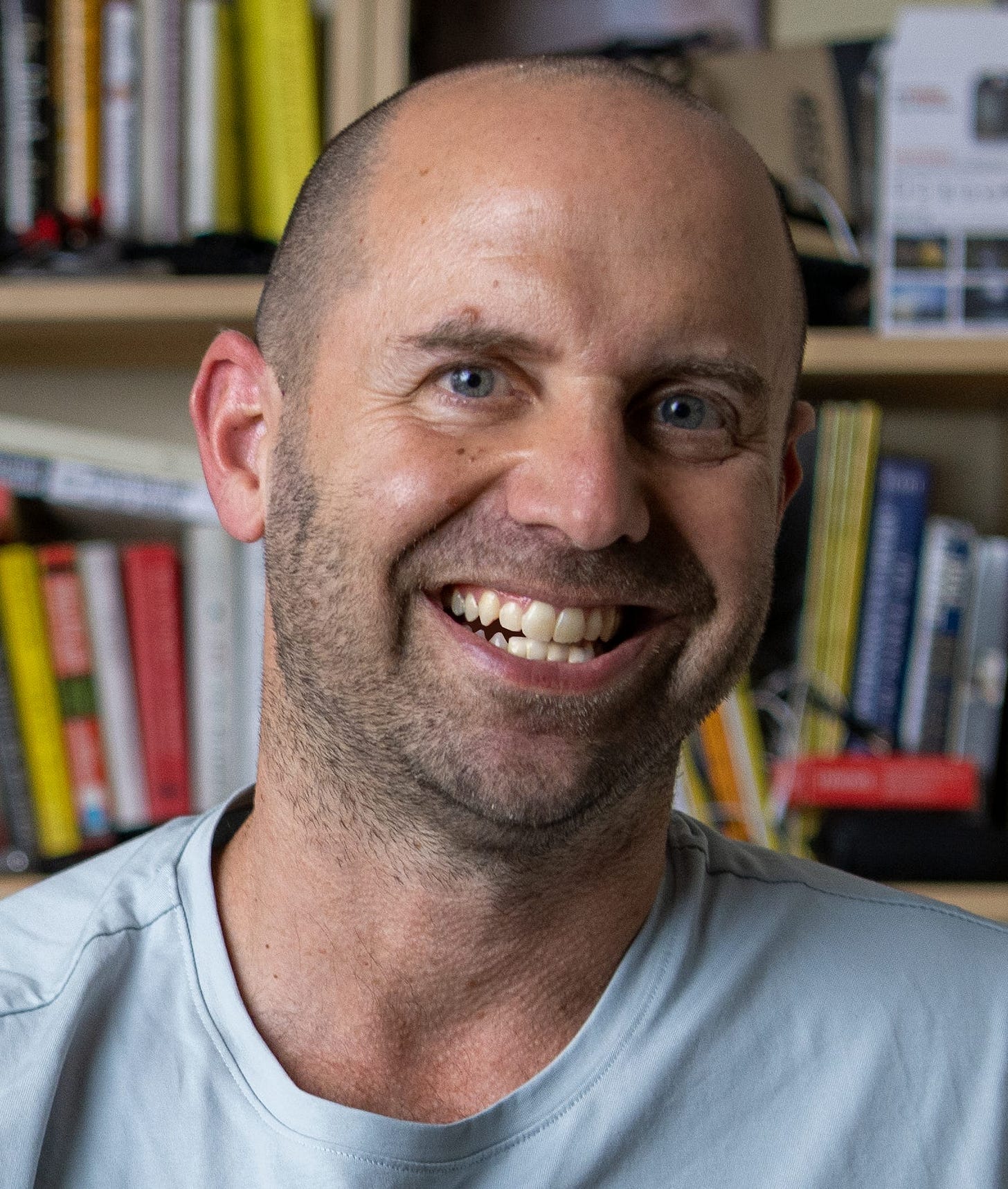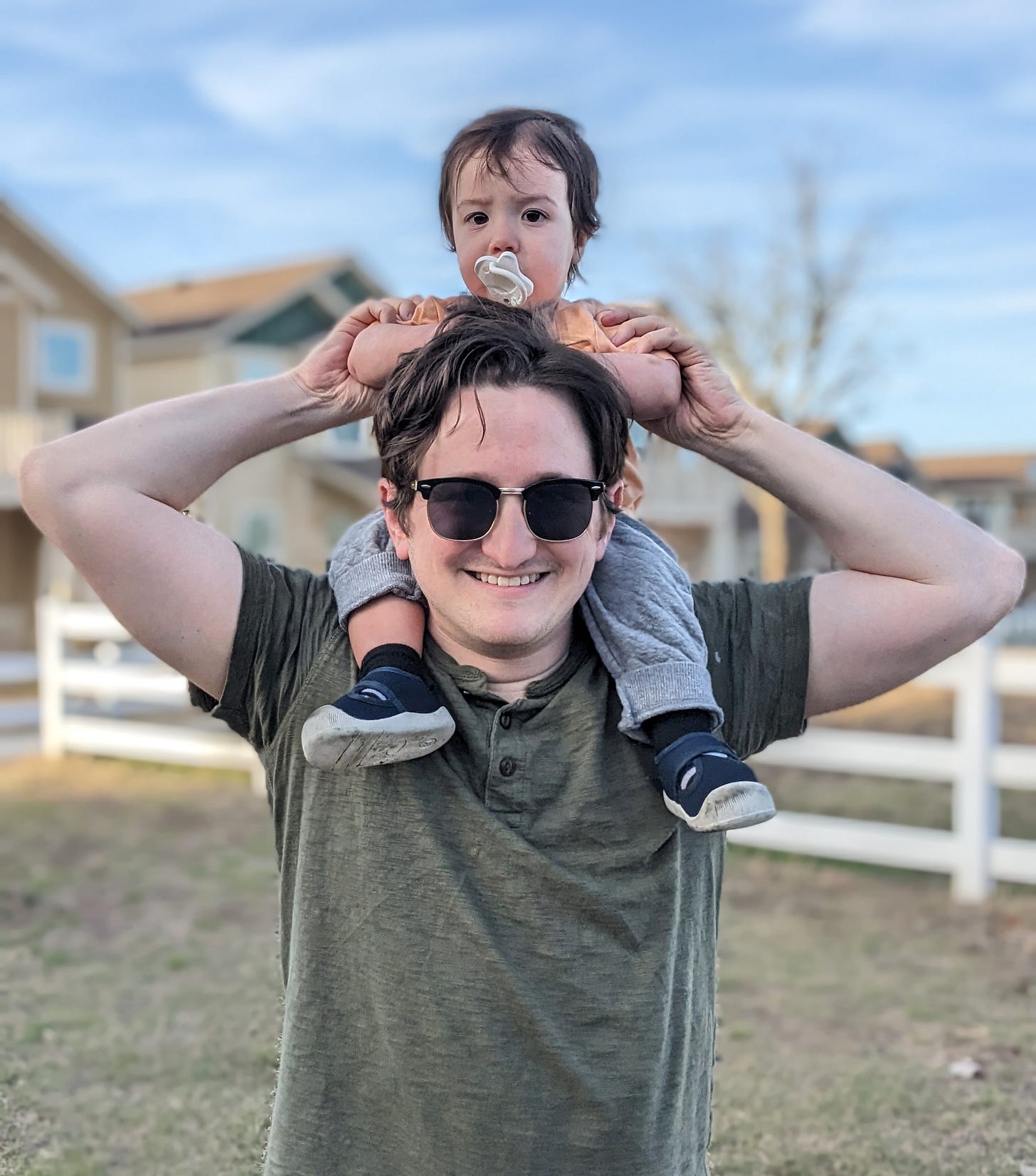Kids, Curiosity, and Censorship: Should We Let Them Swim or Keep the Floaties On?
Two dads enter the most honest parenting debate you'll read all year.
The response to our debate series has been incredible. I hoped it would be a space for honest conversations about the big questions we face as parents - and it’s been so encouraging to see how many of you are not only reading, but engaging. Whether it’s technology, masculinity, mental health, or how we raise kids in a changing world, these debates have sparked the kind of thoughtful discussion we need more of.
So, when today’s writer, Dr. Todd Kashdan, reached out wanting to be part of the series, I was thrilled. If you haven’t seen his newsletter Provoked, it’s a goldmine - smart, sharp, and packed with insight into how we think, grow, and connect. Dr. Kashdan is a professor of psychology, a TEDx speaker, and the author of books like The Art of Insubordination and The Upside of Your Dark Side. He’s published over 250 scientific articles and worked with everyone from Fortune 500 companies to the Department of Defense.
As you can imagine, when he offered to debate me for this piece, I jumped at the chance. He also told me to just call him “Todd,” which was very generous - but as someone raised in a medical family and married to a nurse, it took everything in me not to reflexively respond with “Yes, Doctor Kashdan.”
I’m excited to share his perspective - as well as my own, for what it’s worth - with you today.
Maturity Has a Bell Curve, Not a Birthday
By Dr. Todd Kashdan
I live next door to a man I genuinely like. Good neighbor, devoted dad, and yet, rigid as a crowbar in a freezer when it comes to what his sons are “allowed” to watch. PG-13 movies? Not until 13. R-rated films? Only at 17. Not a minute earlier. Even if it’s a deeply human coming-of-age story. Even if it’s a film that confronts injustice, heartbreak, or moral failure in a way that might expand their brains and hearts.
When his boys asked me to advocate for their case, I found myself in a bizarre philosophical debate at a barbecue, defending their right to experience a world slightly bigger than their birth certificate.
We’re not talking about showing Requiem for a Dream to a toddler. We’re talking about a kid with an advanced reading level, a thoughtful temperament, a real appetite for complexity, and the curiosity to match. Why are we assuming the same media diet works for all children just because they happen to be the same number of years post-womb?
This is the tyranny of averages. And it’s baked into the cultural cake in the United States.
You Wouldn’t Deny a Prodigy a Violin
Picture a 9-year-old who plays Rachmaninoff like it’s no big deal. No one says, “Come back in 4 years when it’s developmentally appropriate to play a piano concerto.” We celebrate prodigies when they play sports or perform music. We let them go where their gifts want to take them.
But emotional prodigies? Perspective-taking prodigies? We pretend they don’t exist. And if they do, we treat them like a threat.
Some kids can metabolize moral complexity before they hit puberty. Some kids crave fiction that makes adults squirm. Some kids are desperate to understand death, betrayal, and addiction because they’re building a framework to hold the chaos of life.
And here we are, holding up a ratings chart like a courtroom exhibit.
Numbers Don’t Parent. You Do.
You want to know what PG-13 means? It means a committee in 1984 decided how many uses of the word “ass” you could tolerate before your soul rotted. It means filmmakers strategically inserting one decapitation instead of two to get their desired sticker. It means marketing.
We’re giving legal power to a thermometer that doesn’t measure your kid’s temperature.
You think your kid is 13. But they might be 13 in height, 9 in emotional regulation, 17 in moral clarity, and 21 in understanding the tragicomic absurdity of human behavior. Development is a jazz solo (not a ladder).
I have a friend whose daughter read The Bell Jar at age 10. Was it age-appropriate? Probably not, if you’re talking about some fictional, protected “average” girl. But it was sanity-saving for her. She experienced depression and the book gave her a language for the pain, a mirror, a sense that she wasn’t alone in the world.
So what happens when you impose arbitrary limits on what they’re hungry for? You teach them that their curiosity is dangerous. You create a black market for wonder.
There’s No Shelf Called “Average”
Bell curves exist for a reason. In any classroom, on any block, there are kids in the top and bottom quartiles of adaptability, self-awareness, story-telling, and persuadability.
Some kids are late bloomers. Some are early bloomers. Some sprout in one direction and not another. One kid might flinch at a cartoon where a turtle gets lost. Another might cry at the end of Schindler’s List and be ready to talk about it.
What matters isn’t the content. It’s who’s watching and who’s guiding the conversation afterward. The job is to walk with them through discomfort. Ask questions. Respond to questions non-defensively. Sit with them and help them make meaning.
Explore the moral mess. Give them tools.
The question is: Will you have built the kind of relationship where they talk to you about it? Or will they keep it to themselves, assuming you’ll never understand?
Dr. Todd Kashdan is a leading expert on well-being, psychological flexibility, and social connection, with over 250 peer-reviewed studies and five books to his name—including The Upside of Your Dark Side and The Art of Insubordination. He’s a professor of psychology, founder of the Well-Being Lab at George Mason University, and his research has been featured in Harvard Business Review, The New York Times, and Hidden Brain. His TEDx talk and bestselling Substack, Provoked, have reached millions with insights on how to live and lead with courage and clarity. Todd is also a father of three (including twins), and a firm believer in good conversation, heavy lifts, and the occasional Italian rainbow cookie.
Kids Are Too Young for Some Things, And That’s Okay
By Dylan Macinerney
You’ve heard it: “Kids today are so advanced!”
Sure, they can unlock a phone faster than I can remember why I walked into the room. They quote memes, master apps, and seem more tech-savvy than many adults. But being capable isn’t the same as being ready.
There’s a growing push for parents to ditch age limits - on what their kids read, watch, or talk about - in the spirit of meeting them where they are. Now, I’ll be the first to tell you, kids vary. Some 10-year-olds are shockingly focused and mature. Others are struggling just to keep up.
But that’s exactly why broad boundaries matter: not because every child is the same, but because no parent has time to custom-vet every single thing their unique child might encounter online, in books, or on a screen. Boundaries exist not to stifle potential, but to protect kids from things they’re not ready to handle - and protect parents from drowning in constant decision-making.
Even imperfect systems - like PG-13 movie ratings or 12+ content filters - offer structure in a world where the content never stops. There’s nothing magical about turning 13, but those age markers give families a shared language, even if we don’t always agree with it or follow it to the letter. They offer predictability in the chaos.
Boundaries don’t say your child can’t ever do something. They say, “you don’t have to decide everything from scratch, every single day.” And that’s a gift.
Boundaries Are a Lifeline, Not a Cage
There’s a misconception that age limits are about control or fear - that they keep kids “in their place.” And to be clear, boundaries can be overused or applied too rigidly, often creating more problems than they solve. But for most families, it’s the opposite. Boundaries make a complicated world simpler and more navigable.
They reduce the daily fog of decisions. They let kids know what’s expected and help adults focus on what really matters, not constantly debating whether this app, that video, or this book is “appropriate.”
My wife and I once spent nearly an hour going back and forth about a block set - debating if the edges were too sharp, the colors too loud, or if it was too advanced for our son. Then we saw the label: 18+ months. He was 9 months old. We could’ve skipped the existential spiral by just reading the box.
Some people assume that strong boundaries reflect weak parenting, but it’s often the opposite. Boundaries are tools that conserve energy and keep things from becoming a free-for-all. They help you say yes to what matters, and no to what doesn’t.
If your kid is exceptional, great, you’ll know. And you can make adjustments. But for the vast majority of kids, and parents, broad, thoughtful limits aren’t a hindrance. They’re a foundation.
Growth Takes Guidance, Not Just Access
Some people worry that boundaries shut down kids’ curiosity: that saying “not yet” might hold them back. But curiosity without support isn’t growth. It’s a setup.
Imagine me walking into a gym and deciding to bench 350 pounds. Now, if you took one look at me, you’d see a guy desperately trying to keep from descending into dad bod territory, let alone someone who can bench double his body weight. That said, with time, guidance and a consistent workout routine, it wouldn’t be impossible for me to get there.
But if a trainer let me try straight away - just because I wanted to - they’d probably lose their license right after peeling me off the floor and explaining to my wife why both my arms are in casts. That’s not strength training. That’s negligence.
A good trainer builds you up gradually. That’s exactly what parents should do for kids.
Curiosity alone doesn’t equal readiness. Just because your child wants to watch a violent movie or read a mature book doesn’t mean they’re equipped to handle the emotional weight. Overloading kids with adult content doesn’t accelerate their development, it often overwhelms it.
Kids don’t grow just by being exposed to things. They grow by understanding them—and that takes context, conversation, and timing. We’ve romanticized the idea that letting kids see everything will make them wise. But that’s like saying someone becomes a chef by licking all the ingredients. It’s not access alone that matters; it’s how they learn to interpret what they see.
When kids encounter stories about violence, injustice, sex, or grief, they don’t just need access, they need help. They need someone to explain, to contextualize, to ask questions. That’s why boundaries matter: not to block forever, but to buy time. Time for support. Time to build towards real understanding.
Giving Kids Time to Be Kids
Here’s the thing about childhood: it’s not a warm-up for real life. It is real life.
It’s not a holding pattern or a problem to be solved. It’s a window of time with its own value: its own speed, its own shape, its own emotional logic. And in a world that’s constantly shouting, “More! Faster! Earlier!” maybe the best thing we can do for them is to say ‘slow down.’
It might sound cliché, but good guidelines let kids be kids.
Yes, some kids are ready sooner. Some are outliers. But most need room. They need space to grow without being pushed too far, too fast. They need adults willing to say “Not yet” without guilt. And honestly? So do most parents.
Boundaries don’t stunt growth. They support it. They’re not about restriction - they’re about rhythm. About pacing. About knowing when to open doors and when to pause at the threshold and say, “We’ll get there. Just not yet.”
And that’s not holding kids back. That’s what helps them move forward - when they’re stronger, steadier, and ready.
Dylan Macinerney is a father, husband, and political professional with over a decade of experience in policy and communications, including five years as a former Congressional staffer. He writes The Fatherhood Framework, a Substack exploring modern parenting, politics, and culture with clarity, conviction, and maybe a few memes. Whether unpacking what’s driving the rising costs of daycare or writing about bedtime with his toddler, Dylan works to bring heart and strategy to the biggest questions facing today’s families.







As you both said the decision (for movie readiness and exposure to life experience) hinges upon a parent's understanding of their child and comfort/ability to discuss mature, confusing or difficult topics and imagery. Otherwise known as intentional parenting. I just watched the Three Amigos with my kids. I know the movie well. El Guapo is pretty rapey, but otherwise it's a wholesome comedy. I was waiting for one particular line; "Do you know what foreplay is? Good. Neither does El Guapo." Either it would fly over my 11 year old's head or he would ask me about it. He went for the latter option, to which I readily responded "It's the beginning part of sex." There were no follow up questions, but I was prepared anyway...
One of those nice debates where I actually agree with both people about everything :)